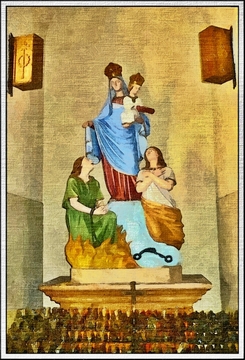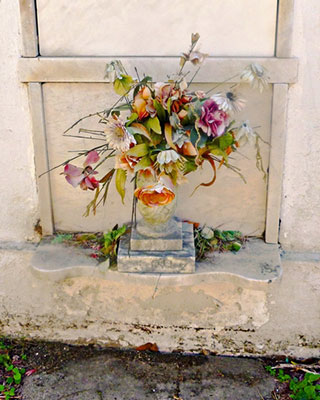
Everlastings and Offerings
-By Debbi Decker
All Saints Day can be a very busy day in New Orleans’ cemeteries. Peering through the gates, you might see a few families busy among the tombs, polishing marble and brass, and pulling the weeds and the ferns that can root in the tiniest of cracks in the surface. There are not as many families present these days as there would have been back in the 1800s and early 1900s. Time has taken its toll on the tombs, and many of the families have either moved away or died out. Still, those that can will take the time to care for the tombs that belong to their families, and there are cemetery preservation societies that are attempting to halt the destruction and decay. Candles continue to be lit, and the priests still come to bless the graves.
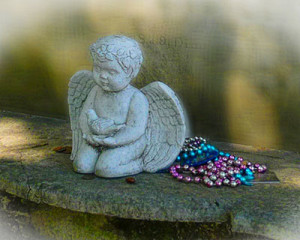
During the 1800s, it was a common practice for vendors to set up outside of the cemeteries around New Orleans on All Saint’s Day to sell fresh flowers to be placed in vases in front of the tombs. Over time, and as people came over to the city from Europe, decorations for the tombs called “immortelles” were introduced to the general public and sold to the families as they entered the cemeteries to clean and decorate the family tombs. The word is of French origin and means “everlasting”. These decorations or offerings would have run the gamut from simple straw flower bouquets to elaborate woven wire wreaths full of beads and china roses. Zinc would have been cut out in the shape of leaves and made into wreaths. Reverse glass paintings of various images and symbols were popular, as were woven hair ornaments. Black roses made out of linen and woven into crosses or other religious shapes were popular. Some of these immortelles were brought over from France, while others were made in New Orleans. Mark Twain commented upon immortelles, stating that “they required no attention… and last like boiler iron”. As advances were made in the silk and plastic flower industries, placing elaborate immortelles on the graves and crypts went by the wayside. The silk and plastic flowers cost less, and families could afford to change out the decorations as often as they wished. There is still evidence that the practice continues in some areas, however, it appears more as a personal afterthought or an offering rather than the actual act of leaving an immortelle as it would have been perceived back in the day.
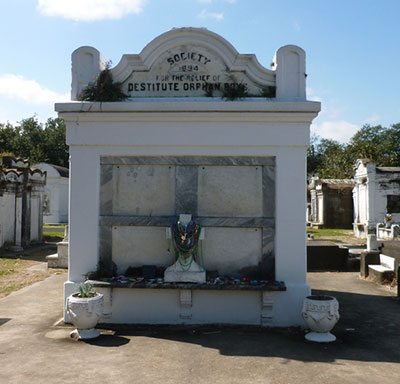
A recent stroll through Lafayette Cemetery No. 1 in the Garden District revealed that the leaving of offerings is still alive and well in New Orleans. Especially at the resting places of people who may have been active in the practice of the Voodoo religion. It also appears that certain crypts have been turned into shrines, as is the case of the tomb of the Society for the Relief of Destitute Orphan Boys (see picture). I have no idea why this particular crypt has now become a shrine and this has only happened in the past two years. When I last visited the cemetery in 2013, there were no offerings on this tomb.
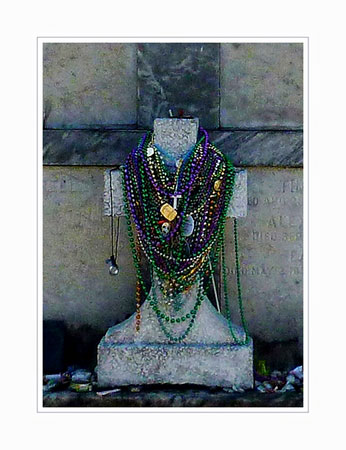
You never know what you will find. During my visit I discovered a hand painted canvas depicting a Mardi Gras mask. Many tombs had beads draped over them, some had metal or glass vases full of actual flowers withered from the heat and passage of time. I noticed a few small toys and tiny cherub statues, as well as bouquets of silk flowers that seemed to fare better in the heat than their living counterparts. Cigarettes, lipsticks, vials of oils and perfumes, cigars and chewing tobacco decorated the crypt’s ledges, as well as small pouches with indeterminate contents to be wondered about or guessed at.
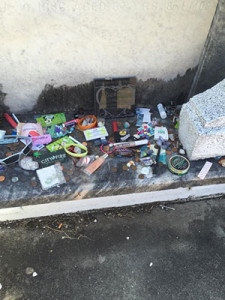
It is not clear from the offerings left what exactly is going on, but as with the Voodoo offerings at the various local mambos’ and houngans’ tombs, I suspect that the petitioners are leaving little gifts behind as thanks for the spirits’ help with their requests. Why these particular tombs are chosen may never be known. And, in a sense, these kinds of offerings become immortelles or everlastings because these offerings will remain. It is acceptable to look over the leavings, and even take a picture or two. You are encouraged to add your prayers and leave an offering of your own. Never ever disturb or take the offerings at these tombs. To do so would anger the spirits and could bring great spiritual harm.
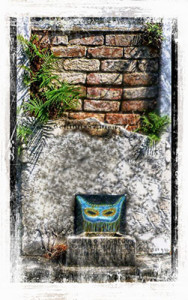
Photographs “Immortelles”, “Blessed the Child”,”Society for the Relief of Destitute Orphan Boys”, “Society for the Relief of Destitute Orphan Boys close up”, “Offerings” and “Mask Gift” provided by Crazed Poppet Creations and are copyrighted images. To contact Debbi Decker for purchase of these prints visit her website.
Debbi Decker is proprietor of Crazed Poppet Creations Art & Assemblage Emporium. Check out her artist page to find links to her shop and blog to read more of her writings. Visit again next month for the telling of hauntings and ghostly tales by Debbi Decker.

